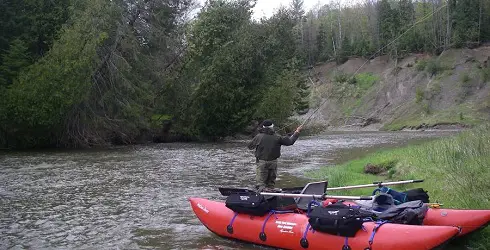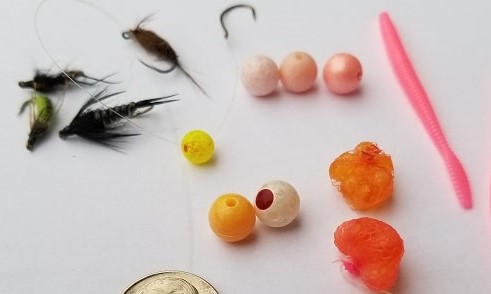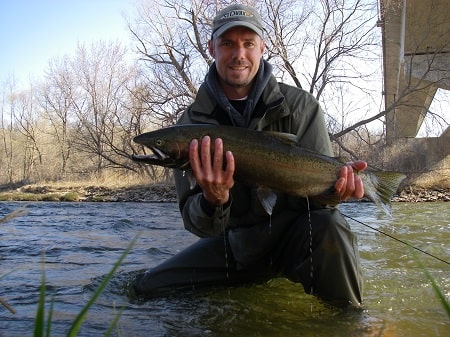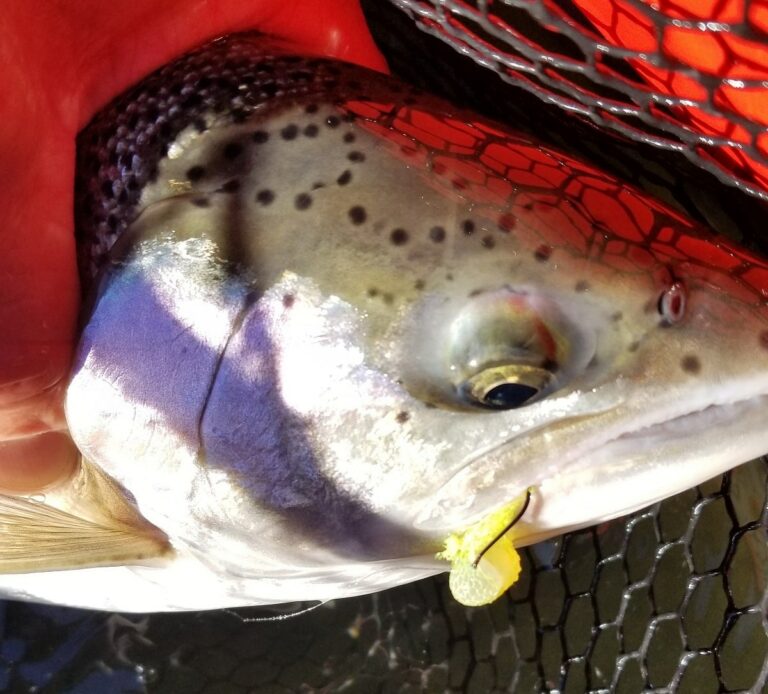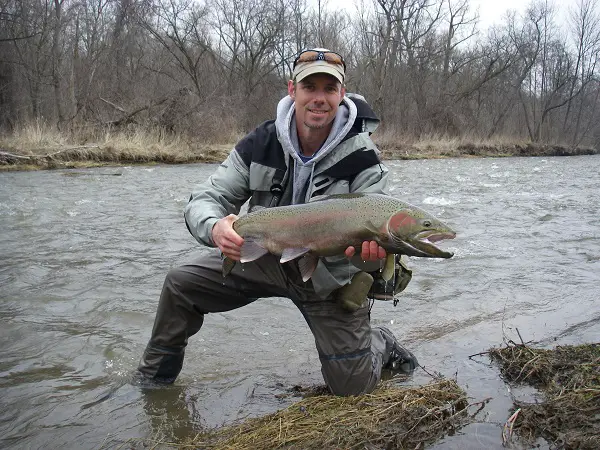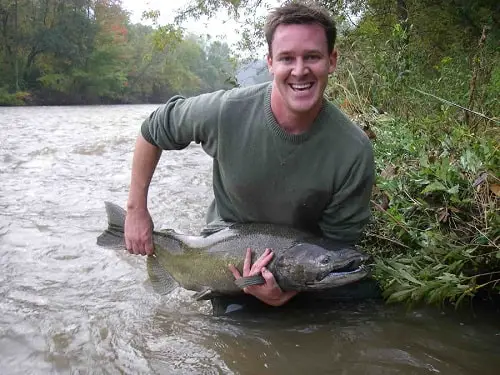Float Fishing In Ontario – When, Where And How
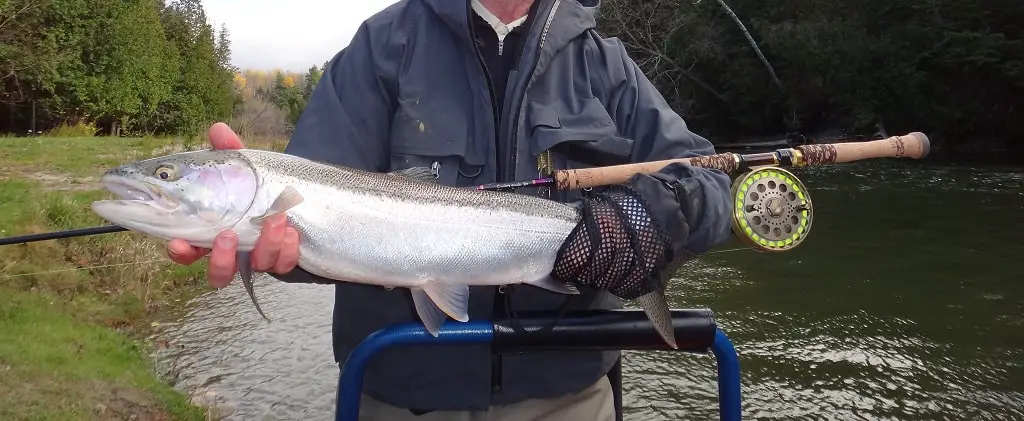
Centerpin And Float Fishing Great Lakes Rivers
Get Centerpin and float fishing tips and advice from the top Centerpin guide in the Great Lakes area. These tips will help you get started and will help you catch more steelhead and salmon.
What Is Float Fishing?
Float fishing is a method that anglers use when fishing rivers to present a bait under a specialized bobber known as a float. Float fishing is best done with long rods over 10 feet and can be done with spinning reels, Centerpin Reels, or baitcasting reels.
The float fishing setup includes a mainline, a float, swivels, a leader, weights, a hook or two, and the bait.
What Is Centerpin fishing?
Centerpin fishing is the same as float fishing except that you are using a special reel called a Centerpin reel. The Centerpin reel is the best reel for float fishing and if it’s done correctly you will be able to catch more fish using a Centerpin reel than any other reel.
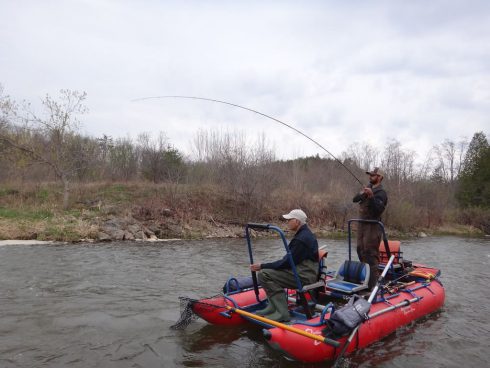
Around the great lakes and in Ontario float fishing is often called “Centerpin Fishing”.
Long rods and a large round reel with no drag are what Centerpin float fishing is all about.
It’s you the float and the fish, and it’s likely the most productive way to catch steelhead and salmon on most of our great lakes rivers.
All around the great lakes, there are lots of good steelhead rivers suitable for centerpin and float fishing. You can float fish or Centerpin fish in both slow and fast moving rivers.
The rivers flowing into Lake Ontario, Lake Huron, and Lake Erie have a lot of great rivers and creeks that are perfect for float fishing for many species like steelhead, salmon, trout.
Some anglers are even using Centerpin reels and float fishing methods for river bass and carp.
There are a lot of advantages to using a Centerpin reel for steelhead and salmon and the guys using Centerpin reels will often out fish everyone else using other methods or using spinning reels to float fish.
With long precise drifts, no mending, and being able to keep your bait in the strike zone for a long time, it’s no-wonder Centerpin fishing is so productive.
HISTORY OF CENTERPIN FISHING
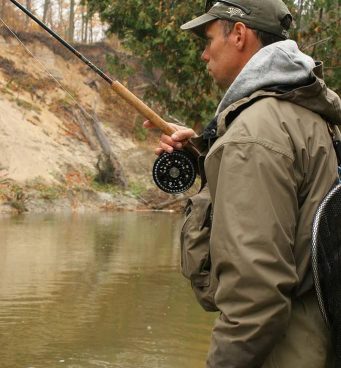
The Beginning Of Centerpining- When I started using a centerpin reel about 30 years ago, I had to wait about 5 days on the water before I finally saw another angler using one just so I could see how they cast it.
Trying to cast a centerpin reel without ever seeing another angler do it seamed impossible. Kudo’s to the first guys to do this well.
Back then anglers like me didn’t have the internet, or books or videos to learn how to centerpin fish or how to cast a centerpin reel. Back then, centerpin fishing was almost unheard of.
Even trying to buy one was tough because most tackle shops didn’t even know what they were.
Everything was new and it was a lot of trial and error learning how to centerpin float fish.
Today, because it’s so much fun and is so effective at catching lots of steelhead and salmon, I’d bet the over 70% of Ontario river anglers use them now.
In fact, it’s hard not to find a centerpin guy on a steelhead or salmon river now.
Some anglers still prefer to float fish using a spinning reel and as a guide, I do this occasionally with some clients but I know it’s much more productive to float fish using a centerpin reel.
CENTERPIN FISHING ONTARIO
Where did it start? Many anglers will tell you that centerpin fishing originated in BC or in the USA, but the truth is it started right here in Ontario.
I’m sure many will disagree but it was years after Ontario anglers were perfecting this style of fishing and catching tons of fish did it finally catch on in the USA and out west in BC.
Although centerpin fishing for steelhead started here in Ontario, centerpin reels were actually originated in the UK where they were used for Carp fishing. Carp anglers would lob out chucks of carp bait on a float into the lake or Locke, they’d set the rod down in a rod holder and wait and while they waited for fish to bite and the centerpin reel would allow the wind or any lake current to pull the line out at a super slow pace to cover the water better.
One day someone from Ontario who saw this got the brilliant idea that this might work in Ontario on our rivers for steelhead, and so began centerpin fishing.
So what is centerpin fishing anyway? This is a question I get asked a lot especially from my USA clients since centerpin fishing is still just starting to catch on there.
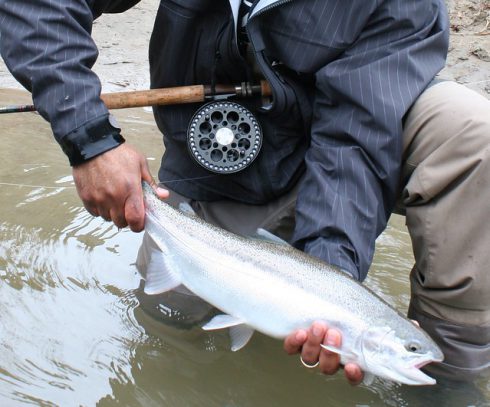
New To Centerpin Fishing?
If you are new to centerpin float fishing and you want to start getting set up but you are like many anglers and you’re not sure what’s good to buy and what’s not, don’t worry, we’ve got you covered.
As a guide in Ontario and who has fished all the states around the great lakes region, I’ve tried and tested so much gear and I know exactly what works and what doesn’t and will give you my honest opinion.
If it’s good enough for me and my clients it’s perfect for you.
I’ll make it simple for you and tell you everything you need, and where to get it. plus more.
How To Centerpin Fish and Float Fish?
Float fishing and Centerpin fishing is a skill and it takes time to get good at it. Many anglers struggle for years before they come to a guide like me that can teach them how to do it right in a few hours.
To help out my clients and friends and you, I have a new blog website where I teach people how to Centerpin fish and it’s free.
I teach that if you can master my 4 fundamentals of Centerpin fishing you start catching far more trout, steelhead, and salmon.
Check out my page Centerpin Fishing For Beginners – 20 Steps to get started. See at www.troutandsteelhead.net
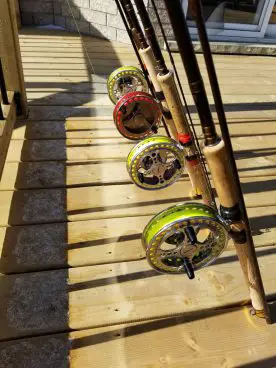
THE CENTERPIN REEL
A Centerpin reel looks a lot like a fly reel or a mooching reel and is basically a spool that sits on a center post or center pin. This allows the spool to spin effortlessly both forward and backward with no drag and very little if any resistance at all.
Centerpin reels have extremely high-quality bearings that allow the spool to spin freely as the current pulls the float down the river. Many reels have such good bearings that even with just a slight breeze the reel can start pinning.
Many of these reels are ported, meaning they’ve got holes or sections removed and are machined so they can be very lightweight.
The Centerpin reels in the picture are an example of what they look like on the rod and with the line on.
As you can see all reels have colored lines, Chartreuse and Pink, which I will discuss later.
On these reels, you can see right through them and this space is why some Centerpin reels are so light. You’ll enjoy that lightweight reel more after a long day on the water.
The main reason for these reels having such great bearings and to be able to free spool so easily is so you can drift a float and a bait like a plastic worm, a roe bag, or fly below the float down the river at a nice natural pace with-out needing to pull line off the reel manually like you would with some other types of reels that guys use when float fishing.
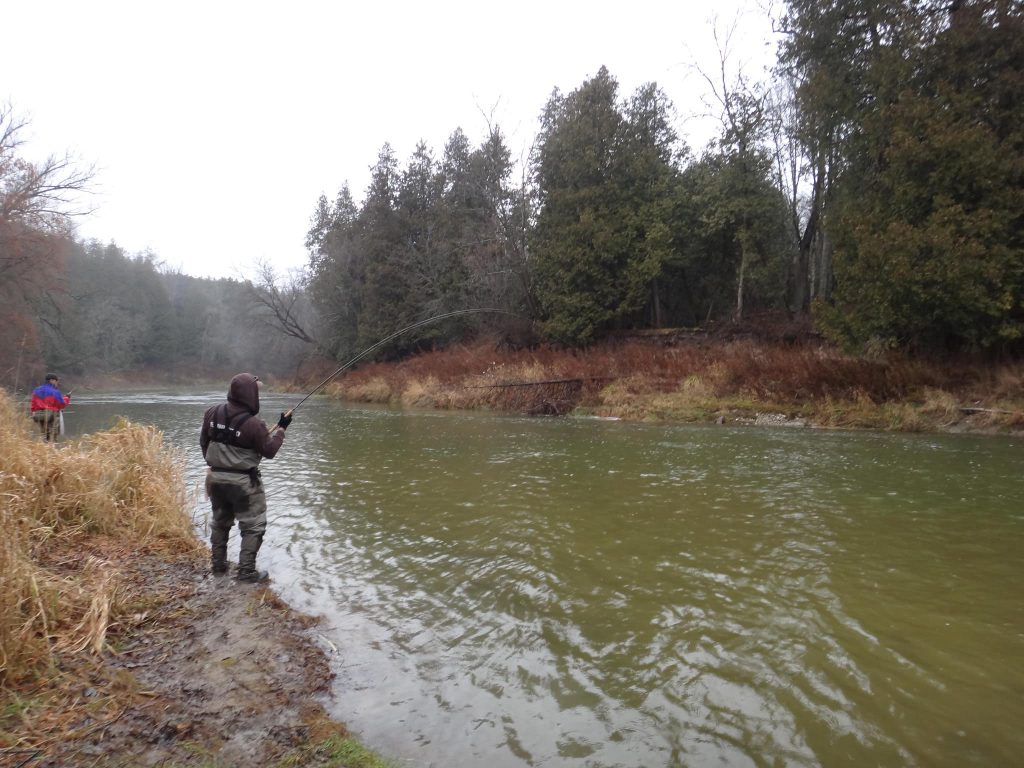
ADVANTAGE OF A CENTERPIN REEL
One of the advantages of the Centerpin reel is the ability to fish very long, long, long drifts, did I say long?
Sometimes while guiding clients on the bigger rivers I’ll have them run their float so far down the river that they eventually lose sight of their floats, and on occasion, I’ll yell “SET” and they’ve got a fish on over 200 feet down the river.
Making long precision drifts like this with other types of reels is nearly impossible and if it is possible to do this with another type of reel it would take a lot more effort. Spinning reels and baitcasting reels usually can not compete with a smooth effortless Centerpin reel.
Because there is no drag on most Centerpin reels it’s a lot of fun and a challenge fishing for big steelhead and salmon on these reels. You can also fish for trout with a Centerpin reel. Check out my recently published articles Centerpin Fishing For Trout – A Guides Perspective. See at www.troutandsteelhead.net
I tell clients new to Centerpin fishing that in most cases I would say 90% of anglers will lose the first big fish they hook using a Centerpin reel so it does take some time getting used to.
I have methods I use to teach guys how to set the hook, play the fish and land it and in many cases, 75% of new anglers leaning from me will land their fish the first time. The guides at A Perfect Drift Guide Company are the best at teaching modern Centerpin fishing methods.
The Best Centerpin Float Reels
Best Reels – What is the best Centerpin Reel? This is a question I get from a lot of anglers.
There are many out there from really cheap to very expensive.
When I owned my tackle store I sold reels from $149 to just over $1000.00 and I have confidence in all of them.
Also, as a guide, I’ve had the opportunity to test out dozens of reels and I can honestly say that a good angler with a $200.00 reel could catch the same amount of fish as a good angler using a $1000.00 reel, so don’t think a more expensive reel will mean more fish in your net.
My advice is simply this. As a beginner, look for a reel in the $180 to $300.00 range and as you get more advanced and more into it then upgrade and either sell the old reel or keep it as a backup.
Or, just keep using the cheaper reel because honestly, chances are you won’t catch any more fish with a more expensive reel anyways.
Unless you’ve got deep pockets, just go straight to more expensive reels. Most of my reels that I fish with and guide with have been between $200 and $400 dollars and they work great.
My warning for beginners is DO NOT go too cheap. I’ve had many clients show up on a guide trip to learn from me and they end up having all kinds of problems and become frustrated with their newly purchased very cheap reel. When they use mine it’s easy to see how much of a difference a reel only $100 more makes.
Some reels are just CRAP!!
And be careful of knock-off reels selling for dirt cheap online. Often the reviews are fake or paid for in some way. I get all kinds of these companies offering me free reels or rods in exchange for a great review so be cautious of the super cheap ones.
If You are in the market for Centerpin Fishing Check out my latest post 23 Best Float Fishing Reels: Buyers Guide – See at www.troutandsteelhead.net
GUIDE TIPS
These are some tips to help prevent potential and possibly costly problems.
- If you are using the sliding rings, once you have your reel set in a place where it feels most comfortable and it lines up perfectly with your guides, make sure the sliding rings are as snug as possible on both sides of the reel foot and then add a piece of electrical tape no longer than 6 inches, at the top and bottom of the reel foot.
Make sure half the tape is on the rings and the other half is on the cork handle of the rod and try to apply it as flat and smooth as possible (not bulky).
This will secure your reel so it won’t fall off unexpectedly.
If you do not secure your reel with tape it could fall off and be dented or broken on the rocks.
If you have any dent’s on the smooth rim that you use as the drag you will feel it with every revolution of the reel when fighting a fish and that sucks!
- Do not lie the reel on the rocks, mud, sand or in the water unless you have no other choice.
- I suggest leaning the rod and reel up against something when releasing a fish or at any other time.
Guys that lie the reel flat on the ground or in the river tend to have issues with dents or sand and grit in the bearings.
- My reels last 5 to 10 years before I need to do any maintenance and I have never needed to replace or lube them because I never lie them down and rarely put them in the water.
The Centerpin Rod
The fishing rods used for centerpin fishing are specifically designed to hold a centerpin reel and in some cases are good for a spinning reel.
However a float rod designed specifically for a spinning reel might have a different reel seat that won’t fit a centerpin reel or be in a position not suitable for a centerpin reel.
Most Centerpin float rods either have a fixed reel seat which is put in the most common spot for most reels or they have a sliding ring reel seat system that allows the angler to put the reel in a spot that suits the angler or is best for the reel.
What’s better, a fixed reel seat or sliding rings?
Well, for some anglers it’s just personal preference but in my opinion, I prefer the sliding rings for a few reasons.
The sliding rings allow you to move the reel up or down the long cork handle and for some, this is more of a comfort thing.
The reels are also different sizes and more importantly different weights so a heavy reel might feel better and balance out the rod better in one position on the rod and a lighter reel may feel better in a different position.
With the fixed reel seat, you can’t adjust it for different reels or for your comfort or style, you just put it on and you’ll just have to get used to it where it is.
Just make sure that if you do use the sliding rings style of float rod that you add some electrical tape to the outsides of the rings to make sure they don’t loosen and drop your reel on the rocks or deep in the rivers.
Best Float Rod Sizes and Types
I have tried so many float rods that I have lost count and to be honest, most of them felt pretty good and I liked them, however, the right float rod may make a difference in catching fish under different river conditions.
A float rod that is too whippy, which I find are often the cheaper rods, won’t give you as good of a hook set or enough backbone to handle bigger fish.
A stiffer and heavier float rod may give you a better hook set but won’t provide the same shock protection for your tippet that you need on the hook set or when fighting big fish
Also, some float rods are designed for the bigger rivers that you might find out in BC or maybe rivers like the Niagara River, and many of these types of float rods may not be so good on an average great lakes river.
For great lakes fishing, I suggest float rods that are considered Medium-Light and with a line weight rating in the 4 to 12lb range. A float rod in this range should be perfect for most great lakes rivers.
I have friends that own $700 rods but they still prefer the feel and action of their cheaper $250 dollar rods. That is why I say that in many cases the float rod that works best for you might just be your personal preference and it could be just the way a float rod feels that can it be the perfect rod for you.
Most medium-light float rods over $150 dollars should be fine for most rivers but remember that the cheaper the rod the heavier it might be and the more whippy it could be.
See my page 5 Best Centerpin Rods for what I recommend to my clients. See at www.troutandsteelhead.net
BEST LENGTH FOR A CENTERPIN ROD
Along with the size comes the length question., what is the best length for a Centerpin rod?
Centerpin rods are long and kind of whippy and can be found in the 10 to 16-foot range but the average rod length and the ones that I recommend for most Ontario rivers are in the 12 to 14-foot range. Most of my guide rods are 13 to 13.5 feet long.
The reason for the extra long rod is that they allow you to make longer casts, keep the line off the water for an extended time which allows you to manage the float and the line longer for a better drift, it makes it easier to mend the line.
The longer float rod also has lots of flex for better shock absorption when setting the hook and when fighting big fish on light lines and light leaders. Light leaders are often the case when fishing for steelhead around the Great Lakes region and in the Ontario rivers.
There are a lot of good Centerpin rods available but and over the years I’ve guided with Raven rods, Loomis rods, St Croix rods, and Okuma rods.
Raven rods have been my first choice for many years and are ideal for great lakes steelhead and salmon rivers.
What Is The Best line For Float Fishing?
Anglers refer to the line on the reel as the mainline so it’s not confused with the leader line at the bottom of the rig.
The mainlines commonly used for Ontario rivers are monofilament or nylon. In some cases, some anglers will use a braided lines.
For monofilament lines for float fishing, I prefer lines in the 6 to 10-pound range. You may be thinking that a 6-pound line is way too light for steelhead but most lines are not rated exactly to the actual breaking strength that the manufacturer claims so most 6 pound lines are closer to 10-pound breaking strength.
For example, I have lifted a 15lb dumbell with 8 to 10lb Trilene and Stren lines along with a few other ones.
I’m not saying that’s a bad thing, all I’m saying is that if you think that 12lb test line is good for steelhead, it may actually be more like 20lb test and that might actually be too heavy and too thick for proper presentation and for good casting.
6-pound line than might be actually 10 or 12 pound-test and I have found that thinner lines cast better and have a bunch of other advantages.
It’s also usually only very advanced anglers that use the 6-pound test lines but these guys know how to fight a fish better than most guys and can apply maximum pressure when needed without breaking fish off.
The best line for float fishing is 8 pounds.
For most rivers around the great lakes is 8lb test will work perfectly. I would not recommend a 6lb line until you are a more advanced angler and even then, 8lb for steelhead in most Ontario rivers for steelhead should be perfect.
Should you be fishing one of our very large or very fast rivers like the Niagara, Grand, Maitland, and Saugeen rivers, or should you decide to fish for salmon, then up-sizing to 10 or 12 lb line is probably a better option.
I do find that guys that come out and fish slower river with 12 to 14 pound mainlines often have a lots of line problems. These thicker lines also cause sag and some lines will sink and that’s all bad so make sure you get the right line.
I discuss my favorite lines on my page 5 Best Float Fishing Lines. See at www.troutandsteelhead.net
What Color Line For Float Fishing
I like to use high visibility lines when float fishing because it helps me and other anglers around me see the line so they don’t cross it.
I also think High viz yellow or orange lines are bets for new anglers to learn on.
Will fish see the colored lines?
If you set your leader up properly using what I call the shot line leader the fish will not see the colored line. If you don’t the fish could see the lines if the line is close enough to your bait.
Having to the line to close to the bait is a common mistake.
For all my fishing, guiding, and Centerpin fishing classes, I use the Raven High-Vis Yellow mainline in 8-pound test. 10-pound line also works well.
Is Braiding Line Good For Float Fishing?
Braided line is good for float fishing and for Centerpin reels as long as you know the few disadvantages of it so that you can avoid them.
Some anglers are using braided lines for Centerpin fishing with good success. The advantage to a braided line on a Centerpin reel is the lack of stretch of the line gives you more solid hooksets, especially when your float is a long way down the river.
However the no strecth of the line can also be a problem. I have guided anglers that kept breaking fish off on the hookset or when fighting fish because there is not stretch on the line to protect lighter tippets.
If this happens I am usually forced to increase my leader size so they stop breaking off fish but increasing your leader size can mean less fish will bite.
An advantage to braided lines is that most of them float and a floating line is a good thing when you need to mend and for setting the hook.
The downsides to braided lines are:
- They are more expensive.
- No stretch can break off fish on the hookset
- They can sometimes absorb water and can freeze like a block of ice around your reel if you get them wet in extreme cold.
- They are almost too strong and you’re more likely to be above the rods line pound recommendation and therefore you are more likely to break a rod with a braided line.
- Some anglers claim the braid can create grooves and damage the rod guides.
I don’t use braided line for the reason listed above.
Best Floats For Float Fishing
If you ever read an article and they tell you using those round red and white bobbers are OK for float fishing leave that page ASAP.
The type of float that you use and how you use your float is really important and anyone that says any different is not an expert and will catch fewer fish.
There are tons of mass-market and custom floats on the market. My two favorites are the Raven floats and the Drennan floats.
The Raven floats are great for visibility and come in a variety of shapes and sizes and the Drennan floats are great for clear water and in situations where a stealthy presentation is required.
The only downside to Raven floats that some angler complain about is their durability. For me they work great and as I say, I’d much rather lose a $2.50 float in a log jam then an $6.50 float.
Most of the time, the floats that anglers use are using are just their personal preference, it’s what they tried and liked so they stick with it and chances are they are probably good enough.
However, there are a lot of really crappy floats out there and I see guys using floats that do nothing but make it tougher to catch fish and they don’t even realize it.
The one thing I tell all my beginner clients is that whatever float you choose make sure it has a pointed top which will greatly aid in determining your bait placement during the presentation.
Also to make sure that the size of the float fits the type of water that you’re fishing.
A float for the Niagara river might be 15 to 20 grams, but a float for a smaller river like the Ganaraska river might be a 4 or 5 gram float.
I also think that an orange top float stands out better in all light conditions so most of the time there is no need for any other color. Some anglers like yellow or chartreuse topped floats when fishing in low light conditions and on cloudy days.
I mostly use the Drennan Loafer floats when the water is gin clear and the fish can be spooked by bigger solid bottom colored floats.
Shopping List:
- RAVEN FM FLOATS – size 4gm, 5gm, and 6.2gm
- FLOAT CAPS this assortment pack is good for many types of floats
- DRENNAN LOAFER FLOATS – great for low clear water – Siz 4gm to 6.4grm is usually good for most river less than 60 feet wide.
I discuss my favorite floats, best sizes, and types on my page 5 Best Centerpin Floats For 2021 – See at www.troutandsteelhead.net
Best Hooks For Float Fishing
I’m always asked what my favorite hook is and what size is best for float fishing.
That answer usually depends on the river or the fish that I’m targeting.
As a general rule, my favorite hooks are the Daiichi 1150 Heavy Wide-Gape Hooks for smaller baits and clear water or the Raven Specimen hook for general purposes and all baits.
I use both in the size #8 or #10 for most steelhead and for most river conditions.
If I’m fishing super clear water where I need smaller baits I’ll maybe drop down to a size 12.
If there is a lot of heavier wood in the area and I need to use a heavier leader to control the fish and prevent them from getting into the wood or when I’m fishing for salmon I use the Gamakatsu Octopus hook.
I may also choose a wider gap hook like the Raven Specimen hook in dirtier water since I believe a wider hook grabs more flesh and is less likely to tear out.
I and many experienced anglers also avoid the gold, red, or any colored hooks and just prefer to stick with the bronze or black hooks.
There are also some really crappy cheap hooks out there that may be dull and weak so they may bend or break more often than the good quality hooks.
If you can’t get Raven Hooks I also like the Daiichi D19Z Octopus hook and Blackbird Sabertooth Premium Hook.
The Best Split Shot For Floats Fishing
Splits shots are an important part of the setup but some split shots are just not good to use.
I do not recommend using the cheap bright silver or any shiny split shot. I also do not recommend using the spit shots with the removable wings as this may cause excess spin in the line.
Only use round dark colored split shots like the Sure Shot brand seen HERE.
The Best Swivels For Float Fishing
It’s common to use one to 3 swivels on your line to help keep twist out of the line and to connect different diameters of line.
I recommend the Raven XX and the XXX small swivels seen HERE.
The Float Leader Setup
It is important that you use the right leader setup when you float fish. The leader consists of leader line, swivels, weights, and your hook.
As a river guide, I go through a lot of leader material. I’m always checking for nicks and scrapes on the leader and change it daily. Because I go through so much I prefer to buy my leaders in large spools which often works out to be much cheaper in the end.
I’ve tried some really bad fluorocarbon lines that break easy so I’m picky about the ones that I use.
For bulk leaders, my favorite line for leaders is the Seaguar Abraz-X in the 6lb test. The 6-pound line is 0.205mm in diameter which is perfect for most steelhead rivers.
At 200 yards it works out to be about $5.50 CAD for 50 yards compared to the normal smaller leader spools that guys use which can be over $15 for 50 yards. That’s a huge saving.
My 3 favorite steelhead leader brands are:
- Drennan in the 3lb, 4lb, and 5-pound sizes. – Check Best Price at FishUSA.com
- Redwing Phantom in the 5.6lb, 6.6lb, and the 7.6-pound sizes – Check Best Price at FishUSA.com
- Seaguar AbrazX Fluorocarbon Line in the 6lb and 8lb sizes – Check Best Price at FishUSA.com Or Amazon Price Here
A word of caution is this, because not every company rates their lines the same, one companies 4lb leader line can be twice as thick or twice as thin as other companies’ 4lb test line.
Therefore when I buy a line I don’t care what pound the company claims it is, what I look for instead is the diameter size and quality.
My Float Fishing Leader Setup
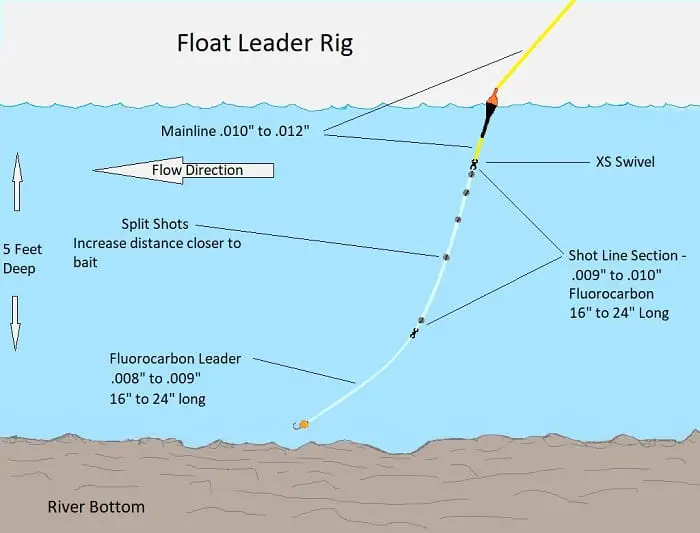
There are many different ways to set up your float fishing leader, some good, some not so good.
Set your float at the depth that puts your bait in the strike zone and doesn’t worry if the bottom part of your leader is well below that.
This is a basic set-up that will get you going in most river conditions and is one I use myself. This float leader setup is also great for anglers that use high viability lines and I use this setup in spots that are 3 to 10 feet deep.
This is the leader setup that has been working great for me for over 15 years. It’s easy and it works. I also use a different float fishing leader setup when fishing deeper rivers.
I also have a 2 bait leader rig and a bead rig that I use.
For detailed information on those and how I construct my leaders go to my page Steelhead Leader Setup: Centerpin and Float Fishing Leader
The Best Steelhead Baits For Float Fishing
There are a lot of different baits that anglers use when float fishing. Different conditions and different times of the year or even different fish can dictate what bait might be best to use.
When I float fish for steelhead I will use these baits:
- Plastic worms – 3 to 4 inches is best when float fishing – Red, Pink, and Brown are all good. see my page Fishing With Worms For Trout and Steelhead: 10 Guide Tips – See at www.troutandsteelhead.net
- Spawn Bags – spawn bags are great for float fishing. I use Pink, Chartreuse, White and Orange are great. Go to my page Spawn Bags – Guide Secrets For More Fish – See at www.troutandsteelhead.net
- Beads – These are great for steelhead. Use plastic beads or glass beads when float fishing – See my page Fishing With Beads: 5 Guide Tips For More Fish – See at www.troutandsteelhead.net
- Flies – There are all kinds of great flies that will catch steelhead under a float. check out my page 5 Best Flies For Steelhead – An Expert Guides Advice – See at www.troutandsteelhead.net
For all the best baits to use when Centerpin fishing for steelhead check out the 4 Best Steelhead Baits – See at www.troutandsteelhead.net
Bait Thread
Raven Elastic Bait Thread – This elastic thread is what I use to tie off the mesh on my roe bags without any knots, I just rap 5 to 10 times and snap it off and then trim the excess mesh.
This is the best thread that I have tried. It may be a little more expensive than some others but the dispenser is better and you get way more than some other brands. MORE . . . . .
Spawn Netting
Blackbird Spawn Net – This is my favorite mesh for tying roe bags. It’s a soft, undetectable netting used for making egg sacs. MORE . . . . .
- Chartruese for dirty stained water.
- Hot pink for colored and stained water.
- Peach, Salmon, and Orange for slightly dirty or clearing water.
- White and peach for low clear or cold water.
Blackbird Spawn Scarf – an Alternative for tying roe bags that I use sometimes in the chartreuse color because it’s a tighter mesh and that makes the color stand out more in dirty water. I also have has good success with the lilac color in normal water conditions. It’s one piece at 27″ x 27″, it will yield approximately 81 pieces of material. MORE . . . . .
- Chartruese for dirty stained water.
- Hot pink for colored and stained water.
- Peach, Salmon, and Orange for slightly dirty or clearing water.
- White and peach for low clear or cold water.
River Gear For Float Fishing
Our river gear page covers all the other gear you might need for float fishing like waders and boots, packs and vests, gloves, forceps, nippers, etc. Don’t forget to check it out.
How To Cast A Centerpin Reel
Once you’ve got all the gear for centerpin fishing the next step is learning how to cast it and learning how to get a proper and the most effective drift.
The Raven Website at this LINK has the best casting tutorials I’ve seen but for actually fishing and getting proper drifts along with fighting fish and more you can’t beat a good coach.
A Perfect Drift Guide Company is Ontario’s premier Centerpin guide service and offers 1 on 1 instruction and Centerpin Fishing Classes.
But as easy as all this sounds and as many fish as some guys catch I still see some anglers catching far more fish than others. It takes a while to get good at casting and fishing with a centerpin when you learn on your own.
Having a buddy that can teach you or even watching that one guy on the river that catches all the fish can really improve your success rate on the river.
If Centerpin fishing sounds like something you’d be interested in one of the fastest ways to learn is also with a qualified guide.
The guides at A Perfect Drift Guide Company have been Centerpin fishing in Ontario for over 25 years and occasionally offer free seminars on the river during the early spring. You can get updates on these events through their facebook page.
Trotting Your Float – Bonus Tip
Trotting – Trotting your float is what they call it when you hold your float back slightly to allow your bait to go ahead of your float.
If done right trotting can greatly increase your catch. The problem is most anglers have no idea why this works and most anglers do it poorly and it’s a big reason why most anglers don’t catch many steelhead.
Proper trotting is one of the first things I teach my clients when I’m guiding them.
Float Fishing and Centerpin Fishing
I hope this helps you get going on your float fishing and Centerpin fishing journey and it helps you put more trout and steelhead in the net soon.
Tight Lines
Graham

